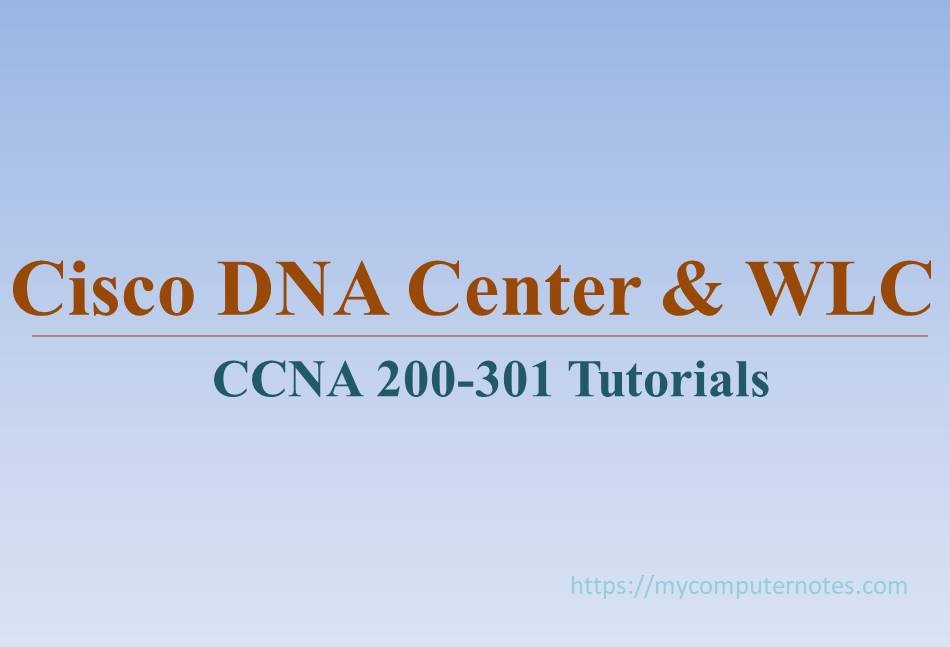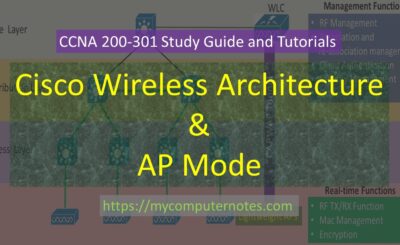In this series of CCNA 200-301 tutorials, we will be going to discuss Cisco DNA Center and WLC. In this topic, it will cover what is Cisco DNA center is, its features and advantages, How Cisco DNA center works. The topic will also cover what is WLC and its roles and functionalities.
What is Cisco DNA center?
DNA in Cisco DNA center stands for Digital Network Architecture.
Cisco DNA centre is intent-based Cisco architecture for the enterprise networks. It provides an open, extensible and software-driven centralized management platform and dashboard for complete control over the performance status of network components.
It simplifies the process of network management and administration according to business needs.
Roles and functionalities of Cisco DNA center
- Cisco DNA center provides a centralized management platform for complete management and control over the enterprise network.
- It is a software-based application that is installed in centralized Cisco DNA appliances to manage the whole network from a single place.
- It provides graphical representation and a programming interface to design our network, configure the network devices and troubleshoot the network.
- Cisco DNA center is an intelligent system combining automation, policy analytics and open platform capabilities.
- It fulfils all the required aspects of the intent-based network. An intent-based network (IBM) is a network administration system that incorporates Artificial Intelligence (AI), network orchestration, machine learning (ML), and automates the administration and management task all across the network.
- The main goal of the Cisco DNA center is to reduce the manual intervention of human-associated with the traditional configuration management. It also reduces the complexity of creating, managing network policies.
- It is the heart of Cisco digital network architecture and the powerful network management system that brings all the functionalities of network components into a single pane of glass.
Roles of Cisco DNA center
The Cisco DNA center has two major roles-
- as the controller in a network that uses Cisco SDA (Cisco DNA centre and SDA are associated closely in the context of network automation)
- as the controller in a non-SDA network management platform for traditional network devices.
Cisco DNA center is an application-based interface and it is pre-installed in a Cisco network component. It interacts with both Northbound API and Southbound API. For most of the users, interaction with the Northbound API matters most because the users of the SDA network interact with SDA using the Northbound REST API or GUI interface of the Cisco DNA centre.
Cisco DNA center also supports several southbound APIs so that the controllers can communicate with devices managed by it.
Telnet, SSH, SNMP are the major protocols that are supported by the traditional network devices. whereas netconf, Restconf supports more modern devices.
Features of Cisco DNA Center
- Design
- automation
- Security policy
- Assurance
- Provisioning
- Platform
Design
The Cisco DNA center is very helpful in designing complex network architecture and its deployment.
Automation
It automates network management in an efficient manner and reduces manual operation. As result, reducing the cost and time. It also minimizes the cost associated with human error.
Security Policy
Different security policies can be defined according to the business needs. Group-based policies can be applied to the network segments and different levels of permission can be applied as per the network hierarchical infrastructure. Policies are applied only to the users and application, but not to the network devices.
Assurance
The Cisco DNA center creates sensors among all wired and wireless devices across the network and delivers real-time reports depending on the actual network conditions. The controller Dashboard scans the entire devices uninterruptedly and checks the real-time performance of the devices. It checks for any performance issues and identifies the most probable cause within a minute.
Platform
Cisco DNA centre provides an open API for the development of network infrastructure. It allows the custom applications to enable IT workflows. It further integrates with the technology domain and collaborated with the other vendor’s network components.
What is WLC?
WLC stands for Wireless Lan Controller.
WLC is a network device that is used to manage the different wireless access points deployed all across the small or large network. The wireless access point or simply wireless AP allows different wireless endpoint devices to connect to the mainstream network. The wireless endpoint devices may be such as laptops, smartphones, wireless printers, scanners etc.
Roles and Functionalities of WLC
Nowadays we are so much accustomed to wireless connectivity wherever we go. After the advent of portable wireless devices such as laptops and smartphones, we want uninterrupted and seamless connectivity on every floor and nook and corner of an office building. For a large enterprise network, the single wireless access point will not be able to connect all the wireless devices. Multiple access points are deployed to provide seamless connectivity.
It is quite easier to manage and administer the wireless access devices for a small network where few numbers of wireless devices are deployed.
But as the size of the network increases, the deployment of the wireless devices also increases. It will be more difficult to administer and manage all these devices separately. Hence, we need some centralised mechanism to control all these devices from a single place. We all want to be connected to our network seamlessly when we switch from one access point to the other. The mechanism of switching wireless devices from one access point to the other access point without disrupting the wireless connectivity is called roaming.
Wireless LAN Controller is the device or the software loaded on the server that manages and controls the wireless access points and the wireless device, thereby ensuring the seamless connectivity when you move from one floor to the other floor of the office building. WLC takes care of all the wireless access from a remote location. and does all the functions like managing, administering and implementing a security policy.
It takes care of managing, authenticating wireless devices, roaming and connecting new wireless networks.
When a new wireless AP is connected to the network. WLC takes control of the new AP. It then administers and manages the new device with the current configuration running for the network.
The main objective of the WLC is to control all the wireless access points centrally from a single point of location. Now access points are just responsible for just forwarding the LAN traffic wirelessly and these access points are then said to be lightweight access points.
WLC uses the protocols called LWAPP to manage and control large numbers of access points. LWAPP stands for Light-Weight Access Point Protocol.
| ←Prev | Next→ | |
| Next-gen Firewall and WLC |
Endpoints and Servers






